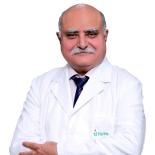About Heart Transplant
Heart transplant stands as an elevation of modern medicine, providing renewed life and hope to those with end-stage heart failure. In recent decades, this procedure has evolved into a life-saving option, transforming the prognosis for many patients. Let’s delve into the intricate world of heart transplantation, exploring the indications, types, future challenges, and post-transplantation management.
Common Conditions
A heart transplant is recommended for individuals suffering from unmanageable cases of acute and chronic heart failure. Some of the primary indications in such cases include:
- Idiopathic Cardiomyopathy: Idiopathic cardiomyopathy is heart muscle disease without a known cause. It leads to heart enlargement and weakens its function, necessitating the need for a heart transplant in severe cases.
- Ischemic Heart Disease With Left Ventricular Failure: These are the group of syndromes often encountered for the cause of heart failure that arises from left ventricular dysfunction (LVD) stemming from myocardial ischemia or infarction, with prevalent risk factors such as hypertension and diabetes.
- Congenital Heart Disease: Anatomical cardiac defects that exist from birth are referred to as congenital heart disease. These flaws, impairing heart function, can impact the heart’s walls, valves, or blood vessels.
Types of Heart Transplant
- Orthotopic Heart Transplant: It involves removing the failed heart and replacing it with a healthy donor heart. The recipient’s heart is excised, leaving behind the atria, and the donor’s heart is connected to the major blood vessels. This procedure is commonly performed for end-stage heart failure.
- Heterotopic Heart Transplant: It is a less common procedure where the donor’s heart is implanted alongside the recipient’s failing heart. The donor heart is typically placed in the right chest cavity, and connections are made between the donor heart and the recipient’s circulatory system. This technique is used in cases where removing the recipient’s heart entirely might pose higher risks.
Criteria for Heart Transplant
According to American Heart Association guidelines for chronic heart failure in outpatient settings, patients may be referred for a heart transplant if they:
- Have ongoing symptoms and complications, such as renal damage, that are linked to heart issues despite using recommended medications.
- Experience frequent hospital visits for heart failure, even with medication.
- Face side effects or cannot use recommended medications.
- Show worsening right heart function or high lung artery pressure.
- Have frequent severe heart rhythm issues that don’t respond to treatment.
- Show other signs like anemia, weight loss, or liver issues due to heart failure.
In case of acute heart failure, patients needing urgent referral for heart transplant may have:
- Severe heart shock despite strong medications and mechanical heart support
- Severe lung swelling is not improving with medications and requires ventilation.
- Severe heart rhythm issues are not getting better with medicines or other procedures.
A successful heart transplant relies on a specialized team comprising cardiothoracic surgeons, cardiac anesthesiologists, cardiologists, perfusionists, and nursing staff. This comprehensive team ensures expertise and diligent care throughout the entire procedure. Among the most critical aspects is preserving the donor organ from the moment it is removed from the donor’s body until it is transplanted into the recipient.
Organ Preservation Techniques
The process of organ preservation has seen significant advancements over the years, and ongoing research aims to improve outcomes further and expand the availability of donor organs. The standard techniques used for organ preservation include:
- Cold storage (Static cold storage)
- Machine perfusion
- Normothermic perfusion
Challenges and Future Directions of Organ Preservation
- Prolonged Preservation: Preserving hearts for extended periods is crucial for expanding the donor pool and improving logistics. Research is focused on developing better preservation solutions and refining machine perfusion techniques to extend preservation times further.
- Enhanced Preservation Solutions: Scientists are developing new preservation solutions that better protect the heart from ischemic injury and optimize its function post-transplantation. These solutions reduce inflammation, prevent cell damage, and improve overall outcomes.
- Gene Editing and Modulation: Genetic manipulation techniques might improve organ preservation. For example, modifying genes involved in ischemia-reperfusion injury could make organs more resilient to damage during preservation and transplantation.
- Organ Assessment Tools: Advances in imaging and diagnostic technologies allow for better assessment of organ quality before transplantation. Machine learning algorithms are being developed to interpret imaging data and predict outcomes based on the condition of the donor’s heart.
- Immunomodulation: Strategies to modulate the recipient’s immune response to reduce the risk of rejection are being investigated. This approach includes personalized immunosuppressive regimens tailored to individual patients.
- Remote Transplantation: The “remote” or “virtual” transplantation concept involves transporting donor organs over longer distances. This could expand the donor pool by allowing organs to be transported from more distant locations.
Follow-up and Care After Heart Transplantation
After a heart transplant, immediate care is crucial to allow the body to accept the new heart. Follow-up procedures include the following:
- Monitoring involves intraoperative transesophageal echocardiography, continuous monitoring with devices such as an intra-arterial line, pulmonary artery catheter, and cardiac telemetry. Additionally, ionotropic medications are used to support heart function.
- Management includes prompt detection of complications, such as primary graft dysfunction (LV/RV/biventricular), cardiac tamponade, and RV dysfunction in high pulmonary resistance.
- Long-term care focuses on checking heart function, spotting rejection, artery problems, and side effects of medication.
- For early transplant, regular endomyocardial biopsies, coronary angiograms, intravascular ultrasound, and periodic laboratory evaluations are essential for the immediate detection of complications post-heart transplant.
Conclusion
Heart transplant is referred to as the gold standard treatment of modern medicine, providing renewed life to those with end-stage heart failure. Evolving into a life-saving option, it transforms prognoses. The journey from indications to types, challenges, and post-transplant care illuminates a field of hope. Advancements in organ preservation and ongoing research promise a brighter future for transplant recipients worldwide.
Our Team of Experts
View allMedical Procedures for Heart Transplant
View allOur patient’s stories
View allRelated Specialities
Other Specialities
-
Explore Hospitals for Heart Transplant
-
Explore Doctors for Heart Transplant by Hospital
Doctors in Fortis Escorts Heart Institute, New Delhi Doctors in Fortis Hospital BG Road Bangalore Doctors in Fortis Hospital, Rajajinagar, Bengaluru Doctors in Fortis Hospital, Noida Doctors in Fortis Hospital, Kalyan, Mumbai Doctors in Fortis Nagarbhavi Bangalore Doctors in Fortis Hospital, Manesar, Gurugram



















